Market
This Is Why Vitalik Buterin Is Confident in Ethereum’s Future
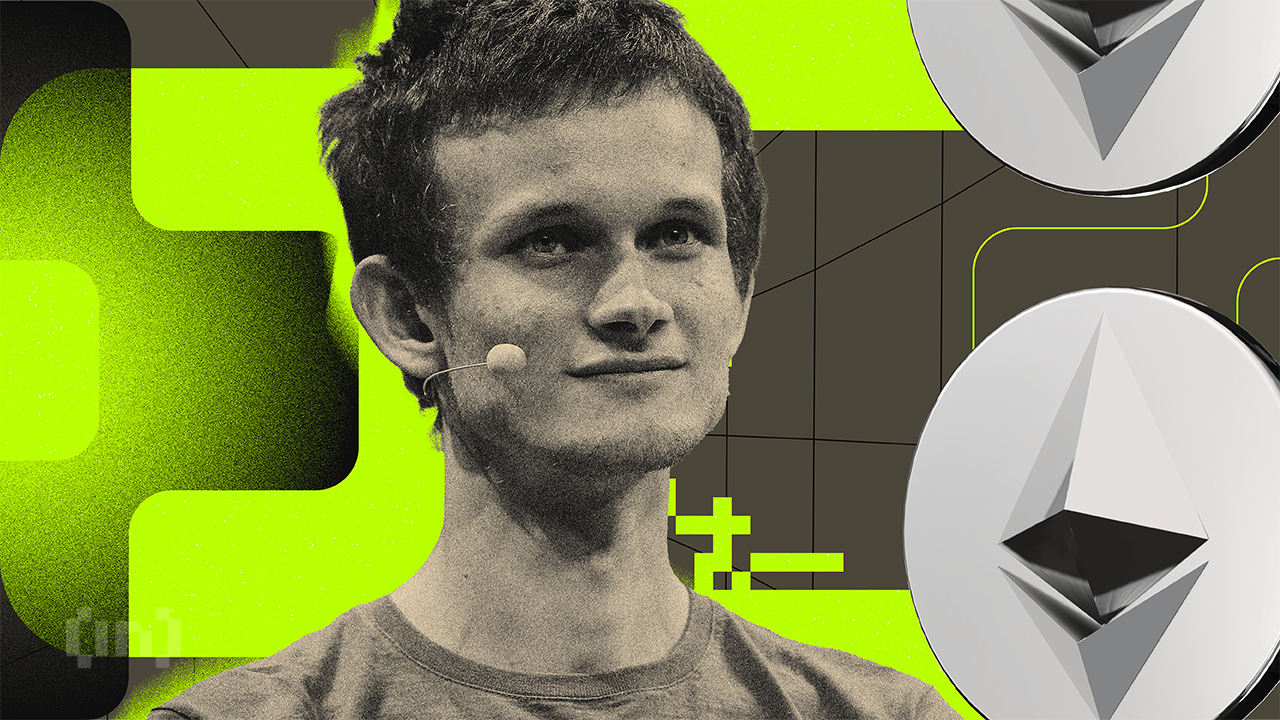
Ethereum (ETH) co-founder Vitalik Buterin has sparked curiosity among community members by promoting the largest altcoin by market cap.
Known for his philosophical insights, the Russo-Canadian innovator recently noted that his followers have been asking him to cut back on the “philosophizing” and do more “Ethereum bull posting.”
ETH Fundamentals ‘Crazy Strong’ — Vitalik Buterin
After publishing his blog titled “Plurality philosophy in an incredibly oversized nutshell,” Buterin mentioned that many of his followers want “less philosophizing and more Ethereum bull posting.” This change in tone sparked speculation, with one user jokingly suggesting Buterin had sold his X (formerly Twitter) account. They noted the difference in his usual content style.
“Vitalik 100% sold their account comparing their early posts to their posts now completely different in almost every way, the language, the nomenclature, the phrasing, practically everything. People don’t change that radically that quickly, regardless of personal situation,” one user expressed.
In a recent development, Vitalik Buterin strongly defended Ethereum after a user questioned its strength in the current market cycle. The critic argued that Layer-1s and Layer-2s are nearing bankruptcy, with investors losing up to 80% of their value.
“Hey Vitalik, Ethereum has weakened a lot in this cycle, layer-1 and layer-2 projects in the ecosystem are almost going bankrupt, and investors have already lost up to 80%, what will happen?” the trader wrote.
Read more: How to Invest in Ethereum ETFs?
Challenging the bearish outlook, Buterin stated that “Ethereum has gotten stronger.” He highlighted key factors such as transaction fees on Layer-2 solutions dropping to less than $0.01 and pointed to Arbitrum and Optimism as Ethereum Virtual Machines (EVMs) now in Stage 1. Buterin further said that the “fundamentals for Ethereum are crazy strong right now.”

While Buterin highlights Ethereum’s strong fundamentals, Ignas, co-founder of DeFi studio Pink Brains, argues that it’s easy to be bearish on ETH. He cites Ethereum’s underperformance relative to Solana (SOL) and Bitcoin (BTC), noting that bearish sentiment is widespread.
However, Ignas remains optimistic, suggesting that Ethereum’s upcoming Pectra Upgrade could act as a bullish catalyst. This upgrade might renew investor confidence and shift market sentiment in favor of ETH.
Ethereum Plans Changes With Pectra Upgrade
The Ethereum blockchain has scheduled the Pectra Upgrade for the first quarter of 2025. This hard fork combines the Prague and Electra upgrades, aimed at enhancing the execution and consensus layers of the network, respectively.
Key features of the Pectra Upgrade include an increased staking limit, PeerDAS/rollup improvements, and enhancements to the EVM. Ethereum developers chose to delay the upgrade’s release until after Devcon in November 2024, prioritizing thorough testing and monitoring based on lessons learned from previous upgrades.
Although Pectra is considered a relatively minor update, Ethereum Foundation protocol support lead Tim Beiko and Vitalik Buterin have also highlighted the upcoming Verkle tree development, another significant upgrade planned for 2025.
“I’m looking forward to Verkle trees. They will enable stateless validator clients, which can allow staking nodes to run with near-zero hard disk space and sync nearly instantly – far better solo staking UX. Also good for user-facing light clients,” Buterin shared.
The Pectra Upgrade follows Ethereum’s Dencun hard fork, which occurred in March 2024. Dencun, which combined Deneb and Cancun upgrades, was intended to lower transaction fees for L2 solutions while improving Ethereum scalability.
While Ethereum’s upcoming upgrades are generating optimism, the network’s deflationary status has been fading since the Dencun Upgrade. According to recent data, Ethereum has experienced a notable increase in ETH supply since mid-April, leading to concerns about its inflationary trend. Despite initial expectations for Ethereum to maintain its deflationary stance following its shift to Proof-of-Stake (PoS), it is now experiencing its longest inflationary period since the transition.
The current inflation rate is around 0.72% per year, according to ultrasound.money. This means that Ethereum is now issuing more units than it is burning, weakening the “ultra-sound money” narrative that has been a key selling point for the network.
Read more: What Is the Ethereum Cancun-Deneb (Dencun) Upgrade?

While the upgrade successfully lowered transaction fees, it inadvertently decreased the total amount of ETH burned on the mainnet. This reduction has resulted in a slower burn rate, pushing Ethereum back into inflationary territory.
“Due to the decrease in on-chain activity, ETH Gas has been below 2 Gwei for a long time since early April this year. In the past four and a half months, the total amount of ETH has increased from 120,063,605 to 120,291,622, and inflation has increased by 228,000. Based on this, the annual inflation will be 600k, with an inflation rate of 0.5%,” blockchain sleuth EmberCN wrote.
Disclaimer
In adherence to the Trust Project guidelines, BeInCrypto is committed to unbiased, transparent reporting. This news article aims to provide accurate, timely information. However, readers are advised to verify facts independently and consult with a professional before making any decisions based on this content. Please note that our Terms and Conditions, Privacy Policy, and Disclaimers have been updated.
Market
Ethereum Price Clings to Support—Upside Break Could Trigger Rally

Reason to trust

Strict editorial policy that focuses on accuracy, relevance, and impartiality
Created by industry experts and meticulously reviewed
The highest standards in reporting and publishing
Strict editorial policy that focuses on accuracy, relevance, and impartiality
Morbi pretium leo et nisl aliquam mollis. Quisque arcu lorem, ultricies quis pellentesque nec, ullamcorper eu odio.
Ethereum price started a increase from the $1,550 zone. ETH is now rising and might attempt to recover above the $1,650 resistance.
- Ethereum started a fresh increase above the $1,580 and $1,600 levels.
- The price is trading above $1,600 and the 100-hourly Simple Moving Average.
- There was a break above a connecting bearish trend line with resistance at $1,590 on the hourly chart of ETH/USD (data feed via Kraken).
- The pair could start a fresh increase if it clears the $1,650 resistance zone.
Ethereum Price Eyes Upside Break
Ethereum price remained stable above the $1,500 level and started a fresh increase, like Bitcoin. ETH traded above the $1,550 and $1,600 levels to enter a short-term positive zone.
There was a break above a connecting bearish trend line with resistance at $1,590 on the hourly chart of ETH/USD. The pair even cleared the $1,620 resistance. A high was formed at $1,644 and the price is stable above the 23.6% Fib retracement level of the upward move from the $1,566 swing low to the $1,644 high.
Ethereum price is now trading above $1,600 and the 100-hourly Simple Moving Average. On the upside, the price seems to be facing hurdles near the $1,640 level. The next key resistance is near the $1,650 level. The first major resistance is near the $1,680 level.
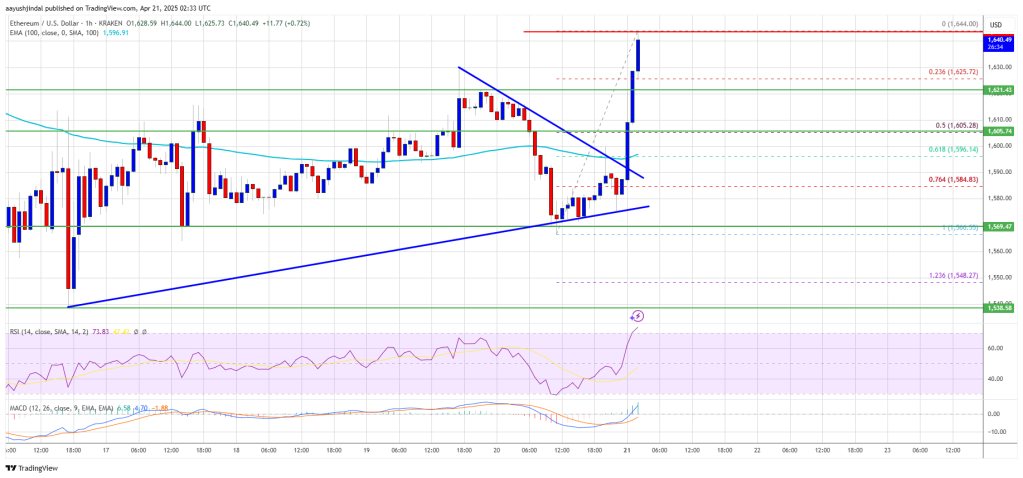
A clear move above the $1,680 resistance might send the price toward the $1,720 resistance. An upside break above the $1,720 resistance might call for more gains in the coming sessions. In the stated case, Ether could rise toward the $1,800 resistance zone or even $1,840 in the near term.
Downside Correction In ETH?
If Ethereum fails to clear the $1,650 resistance, it could start a downside correction. Initial support on the downside is near the $1,620 level. The first major support sits near the $1,605 zone and the 50% Fib retracement level of the upward move from the $1,566 swing low to the $1,644 high.
A clear move below the $1,605 support might push the price toward the $1,580 support. Any more losses might send the price toward the $1,550 support level in the near term. The next key support sits at $1,500.
Technical Indicators
Hourly MACD – The MACD for ETH/USD is gaining momentum in the bullish zone.
Hourly RSI – The RSI for ETH/USD is now above the 50 zone.
Major Support Level – $1,600
Major Resistance Level – $1,650
Market
Will Bittensor Surpass Bitcoin as a Store of Value? Expert Predicts
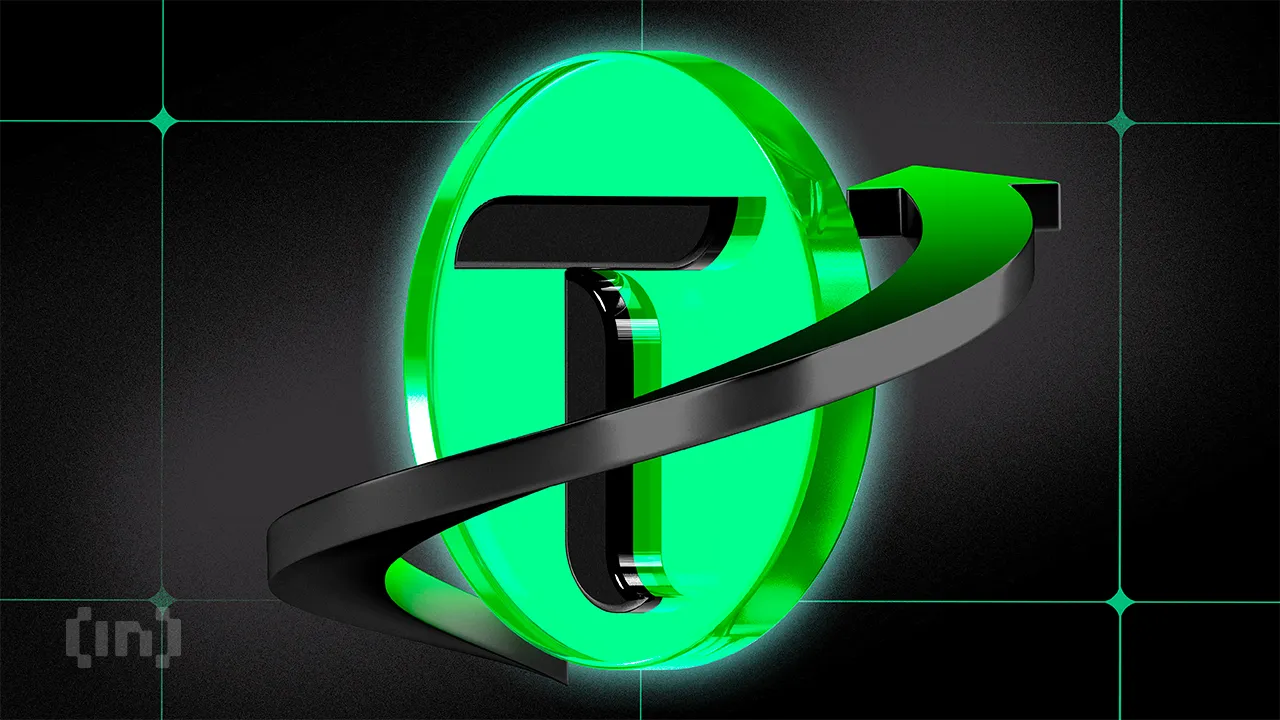
Barry Silbert, CEO of Digital Currency Group, has stated that Bittensor (TAO) has the potential to outperform Bitcoin (BTC) as a global store of value.
His comments come amid notable growth in the Bittensor network, with its subnet ecosystem market capitalization and the TAO token’s price on the rise.
Will Bittensor’s Decentralized AI Model Outperform Bitcoin’s Legacy?
In a recent interview with Raoul Pal, Silbert highlighted the growing influence of artificial intelligence (AI) in the crypto sector. According to him, Bittensor is at the forefront of this revolution, representing the “next big era for crypto.”
“You had the Bitcoin and the Ethereum and the NFTs, and you had the layer 2s and DeFi. I think this is the next big investment theme for crypto,” Silbert stated.
He went on to explain that Bittensor shares the same pioneering spirit as early Bitcoin. Still, its purpose extends beyond financial sovereignty.
“The boldest prediction that I could make for Bittensor is it could be a better version of Bitcoin as a global store of value,” he claimed.
He argued that instead of the $10 to $12 billion spent annually to secure the Bitcoin network, that same amount could be redirected toward incentivizing a global network of individuals working to solve major world problems. He envisions this money fostering innovation on a massive scale, with the potential to grow into a multi-billion-dollar ecosystem.
While acknowledging the value of securing the Bitcoin network, Silbert emphasized that Bittensor’s potential lies in its ability to harness this vast financial backing to address real-world challenges.
He noted that Bittensor operates on a similar economic model to Bitcoin, with halving mechanisms and decentralization, positioning it as a powerful contender in the quest for a more impactful and value-driven global network.
Silbert also noted that while plenty of decentralized AI projects have emerged, Bittensor has set itself apart. He referred to it as having reached “escape velocity.” This term is used to convey a project’s rapid growth and increasing market influence.
“99.9% of crypto tokens that are out there have no reason to exist and are worthless,” he added.
Market data reflects the growing enthusiasm for Bittensor. Notably, amid the ongoing volatility, TAO has fared well in comparison to the broader market, rising 32.1% in the last week. At press time, the altcoin was trading at $328, up 7.2% over the past day.

Additionally, TAO is currently the top trending cryptocurrency on CoinGecko, underlining its rising popularity among investors. Google Trends data further proves the growing interest in Bittensor. The search volume peaked at 100 at the time of writing.
Meanwhile, the Bittensor ecosystem is also seeing notable progress. The latest data indicated that the market capitalization of Bittensor’s subnet tokens more than doubled in April 2025.

It increased by 166%, rising from $181 million at the beginning of April to $481 million at press time. As reported by BeInCrypto, this growth follows a tripling of active subnets over the past year.
Disclaimer
In adherence to the Trust Project guidelines, BeInCrypto is committed to unbiased, transparent reporting. This news article aims to provide accurate, timely information. However, readers are advised to verify facts independently and consult with a professional before making any decisions based on this content. Please note that our Terms and Conditions, Privacy Policy, and Disclaimers have been updated.
Market
XRP Bulls Defend $2.00—Is a Fresh Price Surge Loading?
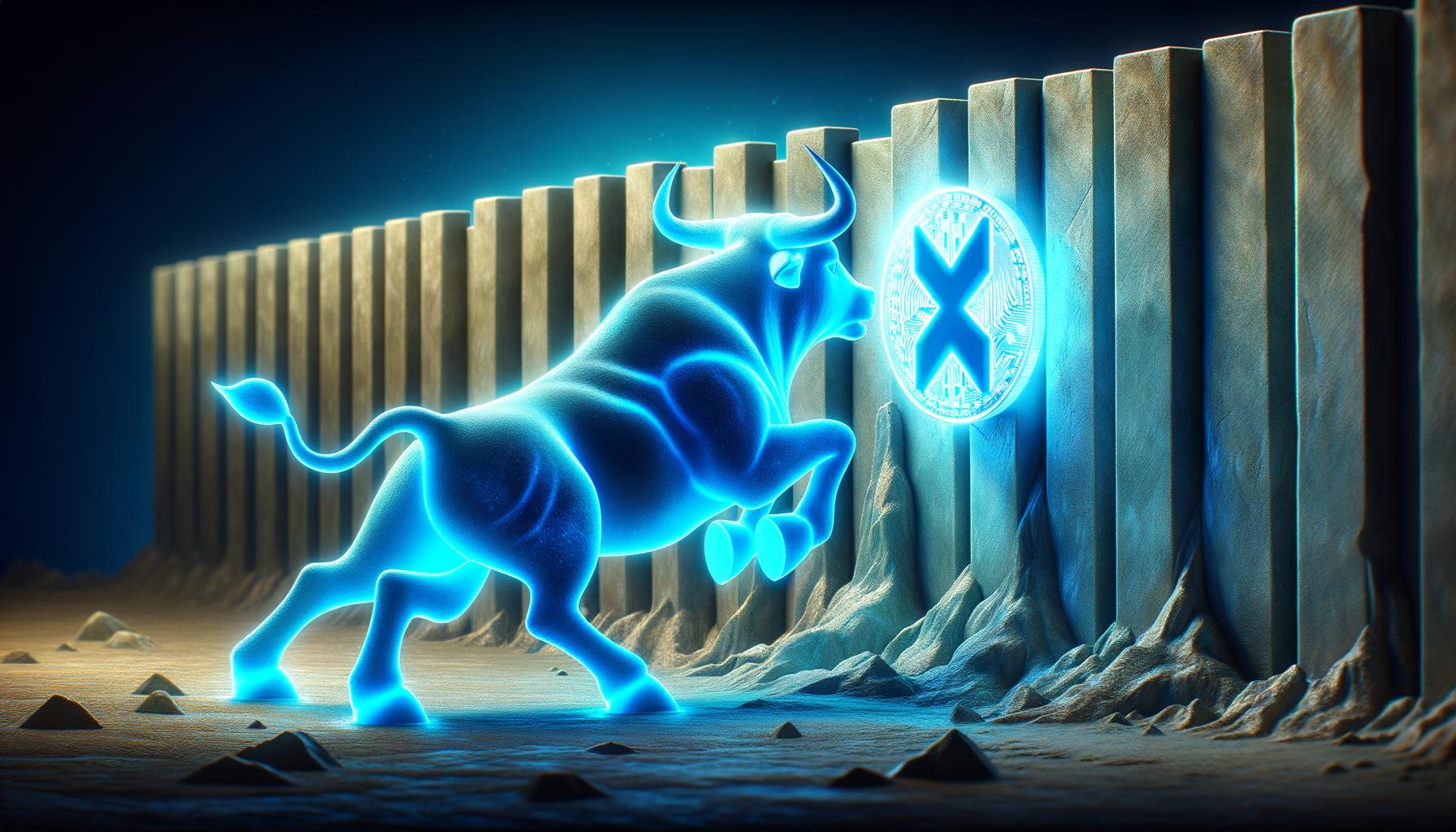
Aayush Jindal, a luminary in the world of financial markets, whose expertise spans over 15 illustrious years in the realms of Forex and cryptocurrency trading. Renowned for his unparalleled proficiency in providing technical analysis, Aayush is a trusted advisor and senior market expert to investors worldwide, guiding them through the intricate landscapes of modern finance with his keen insights and astute chart analysis.
From a young age, Aayush exhibited a natural aptitude for deciphering complex systems and unraveling patterns. Fueled by an insatiable curiosity for understanding market dynamics, he embarked on a journey that would lead him to become one of the foremost authorities in the fields of Forex and crypto trading. With a meticulous eye for detail and an unwavering commitment to excellence, Aayush honed his craft over the years, mastering the art of technical analysis and chart interpretation.
As a software engineer, Aayush harnesses the power of technology to optimize trading strategies and develop innovative solutions for navigating the volatile waters of financial markets. His background in software engineering has equipped him with a unique skill set, enabling him to leverage cutting-edge tools and algorithms to gain a competitive edge in an ever-evolving landscape.
In addition to his roles in finance and technology, Aayush serves as the director of a prestigious IT company, where he spearheads initiatives aimed at driving digital innovation and transformation. Under his visionary leadership, the company has flourished, cementing its position as a leader in the tech industry and paving the way for groundbreaking advancements in software development and IT solutions.
Despite his demanding professional commitments, Aayush is a firm believer in the importance of work-life balance. An avid traveler and adventurer, he finds solace in exploring new destinations, immersing himself in different cultures, and forging lasting memories along the way. Whether he’s trekking through the Himalayas, diving in the azure waters of the Maldives, or experiencing the vibrant energy of bustling metropolises, Aayush embraces every opportunity to broaden his horizons and create unforgettable experiences.
Aayush’s journey to success is marked by a relentless pursuit of excellence and a steadfast commitment to continuous learning and growth. His academic achievements are a testament to his dedication and passion for excellence, having completed his software engineering with honors and excelling in every department.
At his core, Aayush is driven by a profound passion for analyzing markets and uncovering profitable opportunities amidst volatility. Whether he’s poring over price charts, identifying key support and resistance levels, or providing insightful analysis to his clients and followers, Aayush’s unwavering dedication to his craft sets him apart as a true industry leader and a beacon of inspiration to aspiring traders around the globe.
In a world where uncertainty reigns supreme, Aayush Jindal stands as a guiding light, illuminating the path to financial success with his unparalleled expertise, unwavering integrity, and boundless enthusiasm for the markets.
-

 Market18 hours ago
Market18 hours ago1 Year After Bitcoin Halving: What’s Different This Time?
-

 Market19 hours ago
Market19 hours agoVOXEL Climbs 200% After Suspected Bitget Bot Glitch
-
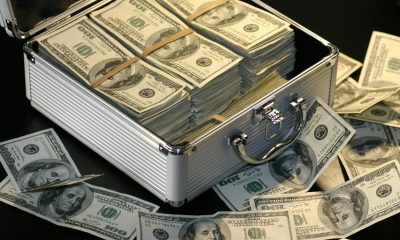
 Market24 hours ago
Market24 hours agoToday’s $1K XRP Bag May Become Tomorrow’s Jackpot, Crypto Founder Says
-

 Market22 hours ago
Market22 hours agoMELANIA Crashes to All-Time Low Amid Insiders Continued Sales
-

 Market17 hours ago
Market17 hours agoTokens Big Players Are Buying
-

 Market23 hours ago
Market23 hours agoCharles Schwab Plans Spot Crypto Trading Rollout in 2026
-
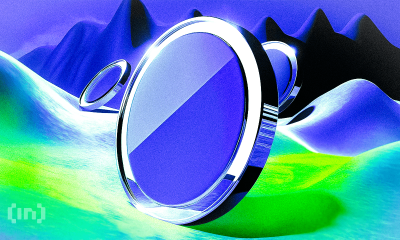
 Market20 hours ago
Market20 hours agoHow Token Launch Frenzy Is Delaying 2025 Altcoin Season
-

 Altcoin20 hours ago
Altcoin20 hours agoBinance Traders Go Big On Dogecoin—Majority Holding Long Positions























